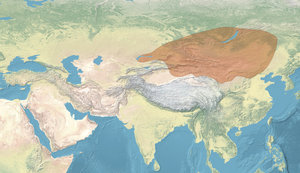{{documentation |content=
The example shown below is for the following, structurally similar, template: {{ Continental Asia in 200 BCE}}.
Usage
{{ Continental Asia in 200 BCE}}{{ Continental Asia in 200 BCE|Parameter 1|Parameter 2|Parameter 3|Parameter 4|Parameter 5}}
Other templates of the same family ( Continental Asia in 200 BCE, Continental Asia in 400 CE, Continental Asia in 1000 CE, South Asia in 600 CE etc...) follow the same format:
Parameters
Use with the following format in Wikipedia articles (all parameters are optional):
|1=: defines the position of the map on a page:|1=center,|1=left,|1=right|2=defines an alternative caption for the map, for example:|2=Asian polities in 500 BCE|3=defines additional objects to place on the map, for example:- A text with hyperlink:
{{ Annotation|227|50| <span class="mw-no-invert" style="color:#4F311CFF">''City of Heaven''</span>|text-aligns=center|font-weights=bold|font-styles=normal|font-sizes=6|colors=#000000}} - A rectangle:
{{ Annotation|175|134|[[File:Long Rectangle (plain).png|40px]]}} - A date mask:
{{ Annotation|0|0|[[File:Continental Asia date mask.png|300px]]}} - An object defined through geographic coordinates
{{ location map~|Continental Asia|lat=37.164722|N|long=69.408611|E|label=|position=|label_size=|mark=Basic red dot.png|marksize=4}}
- A text with hyperlink:
|4=defines an alternative background map, which has to have the same size as the original.|5=if set to|5=none, will remove the border of the map, for use in infoboxes for example.
Example
The basic map would simply require the code {{
Continental Asia in 200 BCE}}, but the code for the same map with an alignement to the right, with a different caption, with an added rectangle for "
YUEZHI" and a geo-located dot for the city of
Ai-Khanoum, with a specially-made map overlay showing
Xiongnu territory (
this map), and without a border, looks like:
{{Continental Asia in 200 BCE
|right
|The [[Yuezhi]], with [[Xiongnu]] territory and main polities of Asia in 200 BCE
|{{Annotation|185|70|[[File:Long Rectangle (plain).png|35px]]}} {{location map~ |Continental Asia |lat=37.164722|N |long=69.408611|E |label=|position=|label_size=|mark=Basic red dot.png|marksize=4}}
|Map of the Xiongnu, circa 150 BCE.png
|none
}}
References
- ^ Haywood, John (1997). Atlas of world history. New York : Barnes & Noble Books. p. Maps 76, 79. ISBN 978-0-7607-0687-9.
- ^ Atlas of World History. Oxford University Press. 2002. p. 51. ISBN 978-0-19-521921-0.
- ^ Fauve, Jeroen (2021). The European Handbook of Central Asian Studies. Ibidem Press. p. 403. ISBN 978-3-8382-1518-1.
- ^ Haywood, John (1997). Atlas of world history. New York : Barnes & Noble Books. p. Map 24. ISBN 978-0-7607-0687-9.
- ^ Török, Tibor (July 2023). "Integrating Linguistic, Archaeological and Genetic Perspectives Unfold the Origin of Ugrians". Genes. 14 (7): Figure 1. doi: 10.3390/genes14071345. ISSN 2073-4425. PMC 10379071. PMID 37510249.
}
{{documentation |content=
The example shown below is for the following, structurally similar, template: {{ Continental Asia in 200 BCE}}.
Usage
{{ Continental Asia in 200 BCE}}{{ Continental Asia in 200 BCE|Parameter 1|Parameter 2|Parameter 3|Parameter 4|Parameter 5}}
Other templates of the same family ( Continental Asia in 200 BCE, Continental Asia in 400 CE, Continental Asia in 1000 CE, South Asia in 600 CE etc...) follow the same format:
Parameters
Use with the following format in Wikipedia articles (all parameters are optional):
|1=: defines the position of the map on a page:|1=center,|1=left,|1=right|2=defines an alternative caption for the map, for example:|2=Asian polities in 500 BCE|3=defines additional objects to place on the map, for example:- A text with hyperlink:
{{ Annotation|227|50| <span class="mw-no-invert" style="color:#4F311CFF">''City of Heaven''</span>|text-aligns=center|font-weights=bold|font-styles=normal|font-sizes=6|colors=#000000}} - A rectangle:
{{ Annotation|175|134|[[File:Long Rectangle (plain).png|40px]]}} - A date mask:
{{ Annotation|0|0|[[File:Continental Asia date mask.png|300px]]}} - An object defined through geographic coordinates
{{ location map~|Continental Asia|lat=37.164722|N|long=69.408611|E|label=|position=|label_size=|mark=Basic red dot.png|marksize=4}}
- A text with hyperlink:
|4=defines an alternative background map, which has to have the same size as the original.|5=if set to|5=none, will remove the border of the map, for use in infoboxes for example.
Example
The basic map would simply require the code {{
Continental Asia in 200 BCE}}, but the code for the same map with an alignement to the right, with a different caption, with an added rectangle for "
YUEZHI" and a geo-located dot for the city of
Ai-Khanoum, with a specially-made map overlay showing
Xiongnu territory (
this map), and without a border, looks like:
{{Continental Asia in 200 BCE
|right
|The [[Yuezhi]], with [[Xiongnu]] territory and main polities of Asia in 200 BCE
|{{Annotation|185|70|[[File:Long Rectangle (plain).png|35px]]}} {{location map~ |Continental Asia |lat=37.164722|N |long=69.408611|E |label=|position=|label_size=|mark=Basic red dot.png|marksize=4}}
|Map of the Xiongnu, circa 150 BCE.png
|none
}}
References
- ^ Haywood, John (1997). Atlas of world history. New York : Barnes & Noble Books. p. Maps 76, 79. ISBN 978-0-7607-0687-9.
- ^ Atlas of World History. Oxford University Press. 2002. p. 51. ISBN 978-0-19-521921-0.
- ^ Fauve, Jeroen (2021). The European Handbook of Central Asian Studies. Ibidem Press. p. 403. ISBN 978-3-8382-1518-1.
- ^ Haywood, John (1997). Atlas of world history. New York : Barnes & Noble Books. p. Map 24. ISBN 978-0-7607-0687-9.
- ^ Török, Tibor (July 2023). "Integrating Linguistic, Archaeological and Genetic Perspectives Unfold the Origin of Ugrians". Genes. 14 (7): Figure 1. doi: 10.3390/genes14071345. ISSN 2073-4425. PMC 10379071. PMID 37510249.
}

